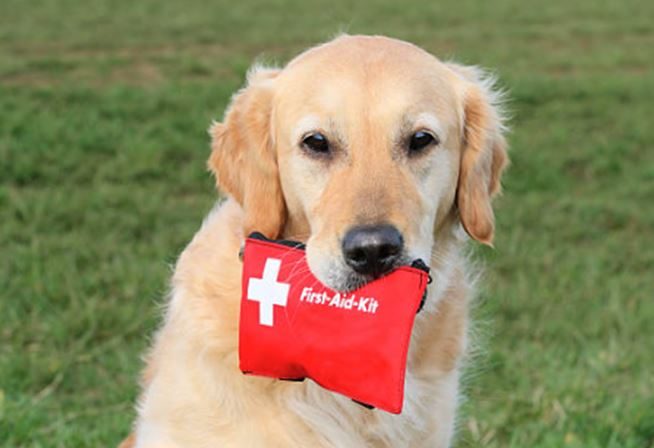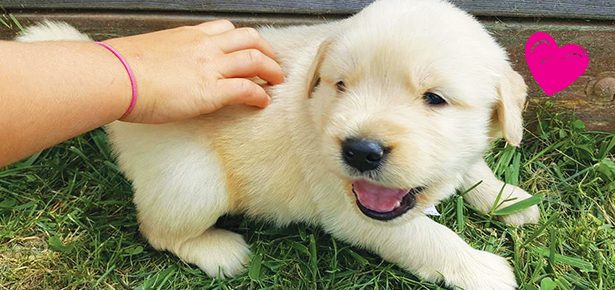

DIY Make your own Canine First Aid Kit
Stay safe but be prepared
A first aid kit is important not only in the event of a natural disaster, but any time you are away from the comfort of your home, vehicle or immediate help.
Just like you have a first aid kit for the humans in your home, it’s important to be prepared with a canine first aid kit. Don’t be caught off guard, as nicks and scrapes are bound to happen and unfortunately, sometimes more serious accidents can occur when camping, driving across the country, or if a natural disaster hits. A first aid kit is the first step in being ready should an animal emergency happen and, with a little preparation and education, pet parents can perform on-the-spot care to help or save their canine family member.
It is best to store your doggie first aid kit in a durable, waterproof container that can travel with you and easily grabbed and taken to wherever your dog may need treatment. If you can’t fit everything into one container, your dog can easily carry some of his own gear! Get him a dog backpack (we love Hurtta’s Trail Pack Harness and Backpack) and store some of the lighter and more essential equipment in there to share the load.
While there are many pre-made kits (the Dayhiker pack from ON THE ROAD PET is a staff favourite), building your own or adding to the pre-made kits is the best way to make sure that everything you have is customized to your pet’s lifestyle and needs.
The following items (categorized into Information, Equipment, Medication, Nutrition, and Staples) will create a comprehensive animal first aid kit. Keep in mind that not everything that works on humans is suitable for Fido and never administer human drugs or prescriptions to your dog without checking with your vet first.
Information
A Canine First Aid Manual – it is easy to panic in the face of an emergency situation. Having a detailed guide to common and uncommon ailments in the palm of your hand will help keep you calm and allow you to give the best possible treatment. Most guides also include instructions on how to use most of the items in your kit.
Emergency Contact Information – have your veterinarian’s number handy as well as directions to the clinic.
Other Important Phone Numbers – Poison Control, Animal Control, and local vet clinics if you are traveling.
Equipment
Tick Remover Tool – Dogs can get Lyme disease too! The sooner you remove a tick, the better and these special tweezers are designed to remove the whole tick, including the embedded head, which if it breaks off and stays in, can lead to infection. The TickZapper is an easy-to-use and chemical-free option that can fit easily in any pocket, first aid kit or pack.
Gauze (pads, squares, and rolls) – gauze is a staple in any first aid kit when used to cover a cut or scrape or to help stop bleeding but a lesser known use is to create a makeshift muzzle on an injured animal.
Slip Lead or Muzzle – when a dog is injured or scared, they can revert to pure animal instincts. This may lead them to bite anyone around, even their owners. If you need to treat a serious injury it is important to have something that can create a muzzle on hand. The lead is necessary to keep an injured animal under control when trying to move them.
Non-stick Bandages or Wraps – if you need to cover a wound to prevent infection or wrap up a sprained limb, use bandages that are made specifically for animals and won’t stick to fur. PawFlex makes fur-safe wraps that are water-resistant, breathable and non-irritating. Funflex bandages from Kruuse also feature an easy-tear so they are quick to grab in the field.
Disinfectant – wound disinfectant wipes using non-sting ingredients like betadine is suggested. Rubbing alcohol is not recommended for open sores or wounds.
Digital Thermometer – human thermometers don’t have a high enough temperature scale to measure a dog’s core temperature. They also have to be used rectally rather than orally. Inform yourself about the normal dog vital signs and how to use the thermometer.
Dog Boots – dog boots are great when used preventatively—Muttluks has lots of great options— but also provide the best protection for a paw that has been injured. The waterproof and sock-like nature of Pawz Dog boots make them perfect for covering up an injured or bandaged paw.
Styptic Pencil – if your dog breaks a nail to the quick or has any other small cuts, a styptic pencil (available at most pharmacies) can stop the bleeding and quickly seal cuts.
Medical Stapler – if your dog suffers a large gash, like from barbed wire, a medical stapler can close the wound quickly and cleanly.
Medication
Wound Spray – Vetericyn makes some great products that are perfect for treatment of lacerations, burns, wounds and other irritations. Try the steroid and antibiotic-free Hot Spot Antimicrobial Gel and Wound & Skin Care Spray to topically clean and heal.
Antihistamine – dogs can get allergic reactions to bug bites, stings and plants. Just like humans, they can take Benadryl orally to calm the itchiness, swelling and hives. It can even be used for snakebites. The dosage is different than for humans and depends on your dog’s size. It will also make your pup drowsy.
Hydrogen Peroxide – while not recommended to clean wounds, fresh 3% hydrogen peroxide can be used to induce vomiting in case of accidental poison ingestion. In some circumstances, vomiting should not be induced so check with a poison control or your vet before administering.
Skin and Paw Balm – dry and cracked paws can be quite painful. Try the all-purpose body balm from Bulldogge Nation that uses micro-silver to soothe and heal dry, cracked noses and paw pads while also helping to heal minor rashes, cuts, and scrapes.
Activated Charcoal – this can help to absorb ingested poisons.
Pain Relief – do not ever use over-the-counter anti-inflammatories (Aleve, Advil or Tylenol) on your dog. They can cause bleeding ulcers, kidney damage, or death. Buffered aspirin is the safest non-prescription anti-inflammatory pain medication for pets. Ask your vet for more information.
Eye Wash – if your dog gets dirt, insects, seeds or any other foreign objects in their eyes, use an eye rinse like the one from Vetericyn. It will flush and clean any irritants and wounds to the eye while offering relief from burning, stinging, itching and any contaminants.
Nutrition
Electrolyte replacement – sometimes water isn’t enough for the fastest recovery from exhaustion and dehydration. While human electrolyte replacements have too much sugar, there are sugar-free alternatives that work for dogs.
Collapsible bowl – while bringing safe water and food may be obvious, some forget to bring containers. Dexas has many foldable, space-saving options including ones that can clip on your pack or your water bottle.
Staples
Tape – preferably 1” medical tape as it is sturdy and easy to tear.
Cotton Balls and Swabs
Cold and Heat Packs – cool down skin after a burn or keep your dog warm if they are hypothermic. Always keep a cloth between the pack and the skin and keep an eye out for redness or irritation.
Disposable Gloves
Bandage Scissors – these scissors have a blunt tip to slip between skin and the bandage to prevent cuts.
Scissors – to cut your dog free or to cut things out of their fur.
Tweezers – to remove splinters or foreign objects from wounds.
Towels and Cloths – used to clean, keep your dog warm or cool, or even as a sling or stretcher for transport.
Penlight or Small Flashlight
Water-based lubricant – for use with rectal thermometers.
Saline Solution – use it to clean wounds, eyes or ears.
Eye Dropper or Turkey Baster – to administer medication or use the saline solution.
Nail clippers or Nail file – to help with cut or broken nails.
Join the newsletter and never miss out on dog content again!
"*" indicates required fields
By clicking the arrow, you agree to our web Terms of Use and Privacy & Cookie Policy. Easy unsubscribe links are provided in every email.





